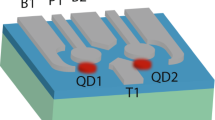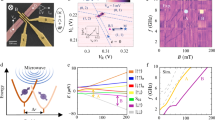Abstract
Spin qubits are considered to be among the most promising candidates for building a quantum processor. Group IV hole spin qubits are particularly interesting owing to their ease of operation and compatibility with Si technology. In addition, Ge offers the option for monolithic superconductor–semiconductor integration. Here, we demonstrate a hole spin qubit operating at fields below 10 mT, the critical field of Al, by exploiting the large out-of-plane hole g-factors in planar Ge and by encoding the qubit into the singlet-triplet states of a double quantum dot. We observe electrically controlled g-factor difference-driven and exchange-driven rotations with tunable frequencies exceeding 100 MHz and dephasing times of 1 μs, which we extend beyond 150 μs using echo techniques. These results demonstrate that Ge hole singlet-triplet qubits are competing with state-of-the-art GaAs and Si singlet-triplet qubits. In addition, their rotation frequencies and coherence are comparable with those of Ge single spin qubits, but singlet-triplet qubits can be operated at much lower fields, emphasizing their potential for on-chip integration with superconducting technologies.
This is a preview of subscription content, access via your institution
Access options
Access Nature and 54 other Nature Portfolio journals
Get Nature+, our best-value online-access subscription
$29.99 / 30 days
cancel any time
Subscribe to this journal
Receive 12 print issues and online access
$259.00 per year
only $21.58 per issue
Buy this article
- Purchase on Springer Link
- Instant access to full article PDF
Prices may be subject to local taxes which are calculated during checkout





Similar content being viewed by others
Data availability
All data included in this work are available from the Institute of Science and Technology Austria repository47.
References
Scappucci, G. et al. The germanium quantum information route. Nat. Rev. Mater. https://doi.org/10.1038/s41578-020-00262-z (2020).
Kloeffel, C., Trif, M. & Loss, D. Strong spin-orbit interaction and helical hole states in Ge/Si nanowires. Phys. Rev. B 84, 195314 (2011).
Froning, F. N. M. et al. Ultrafast hole spin qubit with gate-tunable spin–orbit switch functionality. Nat. Nanotechnol. 16, 308–312 (2021).
Wang, Z. et al. Optimal operation points for ultrafast, highly coherent Ge hole spin-orbit qubits. npj Quantum Inf. 7, 54 (2021).
Lodari, M. et al. Light effective hole mass in undoped Ge/SiGe quantum wells. Phys. Rev. B 100, 041304(R) (2019).
Loss, D. & DiVincenzo, D. P. Quantum computation with quantum dots. Phys. Rev. A 57, 120–126 (1998).
Hendrickx, N. W. et al. A four-qubit germanium quantum processor. Nature 591, 580–585 (2021).
Watzinger, H. et al. A germanium hole spin qubit. Nat. Commun. 9, 3902 (2018).
Hendrickx, N. W., Franke, D. P., Sammak, A., Scappucci, G. & Veldhorst, M. Fast two-qubit logic with holes in germanium. Nature 577, 487–491 (2020).
Katsaros, G. et al. Observation of spin-selective tunneling in SiGe nanocrystals. Phys. Rev. Lett. 107, 246601 (2011).
Levy, J. Universal quantum computation with spin-1/2 pairs and Heisenberg exchange. Phys. Rev. Lett. 89, 147902 (2002).
Petta, J. R. Coherent manipulation of coupled electron spins in semiconductor quantum dots. Science 309, 2180–2184 (2005).
Petta, J. R., Lu, H. & Gossard, A. C. A coherent beam splitter for electronic spin states. Science 327, 669–672 (2010).
Dial, O. E. et al. Charge noise spectroscopy using coherent exchange oscillations in a singlet-triplet qubit. Phys. Rev. Lett. 110, 146804 (2013).
Maune, B. M. et al. Coherent singlet-triplet oscillations in a silicon-based double quantum dot. Nature 481, 344–347 (2012).
Wu, X. et al. Two-axis control of a singlet-triplet qubit with an integrated micromagnet. Proc. Natl Acad. Sci. USA 111, 11938–11942 (2014).
Takeda, K., Noiri, A., Yoneda, J., Nakajima, T. & Tarucha, S. Resonantly driven singlet-triplet spin qubit in silicon. Phys. Rev. Lett. 124, 117701 (2020).
Jock, R. M. et al. A silicon metal-oxide-semiconductor electron spin-orbit qubit. Nat. Commun. 9, 1768 (2018).
Harvey-Collard, P. et al. Spin-orbit interactions for singlet-triplet qubits in silicon. Phys. Rev. Lett. 122, 217702 (2019).
Watzinger, H. et al. Heavy-hole states in germanium hut wires. Nano Lett. 16, 6879–6885 (2016).
Hofmann, A. et al. Assessing the potential of Ge/SiGe quantum dots as hosts for singlet-triplet qubits. Preprint at https://arxiv.org/abs/1910.05841 (2019).
Liles, S. D. et al. Spin and orbital structure of the first six holes in a silicon metal-oxide-semiconductor quantum dot. Nat. Commun. 9, 3255 (2018).
Barthel, C. et al. Relaxation and readout visibility of a singlet-triplet qubit in an Overhauser field gradient. Phys. Rev. B 85, 035306 (2012).
Studenikin, S. A. et al. Enhanced charge detection of spin qubit readout via an intermediate state. Appl. Phys. Lett. 101, 233101 (2012).
Orona, L. A. et al. Readout of singlet-triplet qubits at large magnetic field gradients. Phys. Rev. B 98, 125404 (2018).
Wang, X. et al. Composite pulses for robust universal control of singlet–triplet qubits. Nat. Commun. 3, 997 (2012).
Yoneda, J. et al. A quantum-dot spin qubit with coherence limited by charge noise and fidelity higher than 99.9%. Nat. Nanotechnol. 13, 102–106 (2017).
Moon, H. et al. Machine learning enables completely automatic tuning of a quantum device faster than human experts. Nat. Commun. 11, 4161 (2020).
Shulman, M. D. et al. Suppressing qubit dephasing using real-time Hamiltonian estimation. Nat. Commun. 5, 5156 (2014).
Bluhm, H. et al. Dephasing time of GaAs electron-spin qubits coupled to a nuclear bath exceeding 200 μs. Nat. Phys. 7, 109–113 (2010).
Cerfontaine, P. et al. Closed-loop control of a GaAs-based singlet-triplet spin qubit with 99.5% gate fidelity and low leakage. Nat. Commun. 11, 4144 (2020).
Martins, F. et al. Noise suppression using symmetric exchange gates in spin qubits. Phys. Revi. Lett. 116, 116801 (2016).
Reed, M. et al. Reduced sensitivity to charge noise in semiconductor spin qubits via symmetric operation. Phys. Rev. Lett. 116, 110402 (2016).
Nichol, J. M. et al. High-fidelity entangling gate for double-quantum-dot spin qubits. npj Quantum Inf. 3 3 (2017).
Wallraff, A. et al. Strong coupling of a single photon to a superconducting qubit using circuit quantum electrodynamics. Nature 431, 162–167 (2004).
Stehlik, J. et al. Fast charge sensing of a cavity-coupled double quantum dot using a Josephson parametric amplifier. Phys. Rev. Appl. 4, 014018 (2015).
Burkard, G., Gullans, M. J., Mi, X. & Petta, J. R. Superconductor–semiconductor hybrid-circuit quantum electrodynamics. Nat. Rev. Phys. 2, 129–140 (2020).
Leonard, E. et al. Digital coherent control of a superconducting qubit. Phys. Rev. Appl. 11, 014009 (2019).
Schupp, F. J. et al. Sensitive radiofrequency readout of quantum dots using an ultra-low-noise SQUID amplifier. J. Appl. Phys. 127, 244503 (2020).
Vigneau, F. et al. Germanium quantum-well Josephson field-effect transistors and interferometers. Nano Lett. 19, 1023–1027 (2019).
Amitonov, S. V., Spruijtenburg, P. C., Vervoort, M. W. S., van der Wiel, W. G. & Zwanenburg, F. A. Depletion-mode quantum dots in intrinsic silicon. Appl. Phys. Lett. 112, 023102 (2018).
Rössner, B., Chrastina, D., Isella, G. & von Känel, H. Scattering mechanisms in high-mobility strained Ge channels. Appl. Phys. Lett. 84, 3058–3060 (2004).
Shah, V. A. et al. Reverse graded relaxed buffers for high Ge content SiGe virtual substrates. Appl. Phys. Lett. 93, 192103 (2008).
Wang, Z. et al. Optimal operation points for ultrafast, highly coherent Ge hole spin-orbit qubits. Preprint at https://arXiv:1911.11143 (2019).
Sammak, A. et al. Shallow and undoped germanium quantum wells: a playground for spin and hybrid quantum technology. Adv. Funct. Mater. 29, 1807613 (2019).
Marchionna, S., Virtuani, A., Acciarri, M., Isella, G. & von Kaenel, H. Defect imaging of SiGe strain relaxed buffers grown by LEPECVD. Mater. Sci. Semicond. Process. 9, 802–805 (2006).
Jirovec, D. Research data for “A singlet-triplet hole spin qubit planar Ge”. https://doi.org/10.15479/AT:ISTA:9323 (2021).
Acknowledgements
This research was supported by the Scientific Service Units of Institute of Science and Technology (IST) Austria through resources provided by the Miba Machine Shop and the nanofabrication facility, and was made possible with the support of the NOMIS Foundation. This project has received funding from the European Union’s Horizon 2020 research and innovation programme under Marie Sklodowska-Curie grant agreements no. 844511 and no. 75441, and by the Austrian Science Fund FWF-P 30207 project. A.B. acknowledges support from the European Union Horizon 2020 FET project microSPIRE, no. 766955. M. Botifoll and J.A. acknowledge funding from Generalitat de Catalunya 2017 SGR 327. The Catalan Institute of Nanoscience and Nanotechnology (ICN2) is supported by the Severo Ochoa programme from the Spanish Ministery of Economy (MINECO) (grant no. SEV-2017-0706) and is funded by the Catalonian Research Centre (CERCA) Programme, Generalitat de Catalunya. Part of the present work has been performed within the framework of the Universitat Autónoma de Barcelona Materials Science PhD programme. Part of the HAADF scanning transmission electron microscopy was conducted in the Laboratorio de Microscopias Avanzadas at Instituto de Nanociencia de Aragon, Universidad de Zaragoza. ICN2 acknowledge support from the Spanish Superior Council of Scientific Research (CSIC) Research Platform on Quantum Technologies PTI-001. M.B. acknowledges funding from the Catalan Agency for Management of University and Research Grants (AGAUR) Generalitat de Catalunya formation of investigators (FI) PhD grant.
Author information
Authors and Affiliations
Contributions
D.J. fabricated the sample and performed the experiments and data analysis. D.J., A.H. and I.P. developed the fabrication recipe. D.J., A.H., O.S. and M. Borovkov performed precharacterizing measurements on equivalent samples. J.S.-M. and G.K. fabricated the two additional devices discussed in the Supplementary Information. J.K. performed the experiments on those additional devices. D.C. and A.B. designed the SiGe heterostructure. A.B. performed the growth, supervised by G.I.; D.C. performed the X-ray diffraction measurements and simulations. G.T. performed Hall effect measurements, supervised by D.C.; P.M.M. derived the theoretical model. M. Botifoll and J.A. performed the atomic resolution scanning transmission electron microscopy structural and electron energy-loss spectroscopy compositional related characterization and calculated the strain by using geometrical phase analysis. D.J., A.H., J.K., A.C., F.M., J.S.-M. and G.K. discussed the qubit data. D.J. and G.K. wrote the manuscript with input from all the authors. G.I. and G.K. initiated and supervised the project.
Corresponding authors
Ethics declarations
Competing interests
The authors declare no competing interests.
Additional information
Peer review information Nature Materials thanks Guo-Ping Guo, Yinyu Liu and the other, anonymous, reviewer(s) for their contribution to the peer review of this work.
Publisher’s note Springer Nature remains neutral with regard to jurisdictional claims in published maps and institutional affiliations.
Supplementary information
Supplementary Information
Supplementary Figs. 1–20 and Discussion.
Rights and permissions
About this article
Cite this article
Jirovec, D., Hofmann, A., Ballabio, A. et al. A singlet-triplet hole spin qubit in planar Ge. Nat. Mater. 20, 1106–1112 (2021). https://doi.org/10.1038/s41563-021-01022-2
Received:
Accepted:
Published:
Issue Date:
DOI: https://doi.org/10.1038/s41563-021-01022-2
This article is cited by
-
Strong coupling between a microwave photon and a singlet-triplet qubit
Nature Communications (2024)
-
Parity-conserving Cooper-pair transport and ideal superconducting diode in planar germanium
Nature Communications (2024)
-
Wigner-molecularization-enabled dynamic nuclear polarization
Nature Communications (2023)
-
Hard superconducting gap in germanium
Communications Materials (2023)
-
Probing resonating valence bonds on a programmable germanium quantum simulator
npj Quantum Information (2023)



